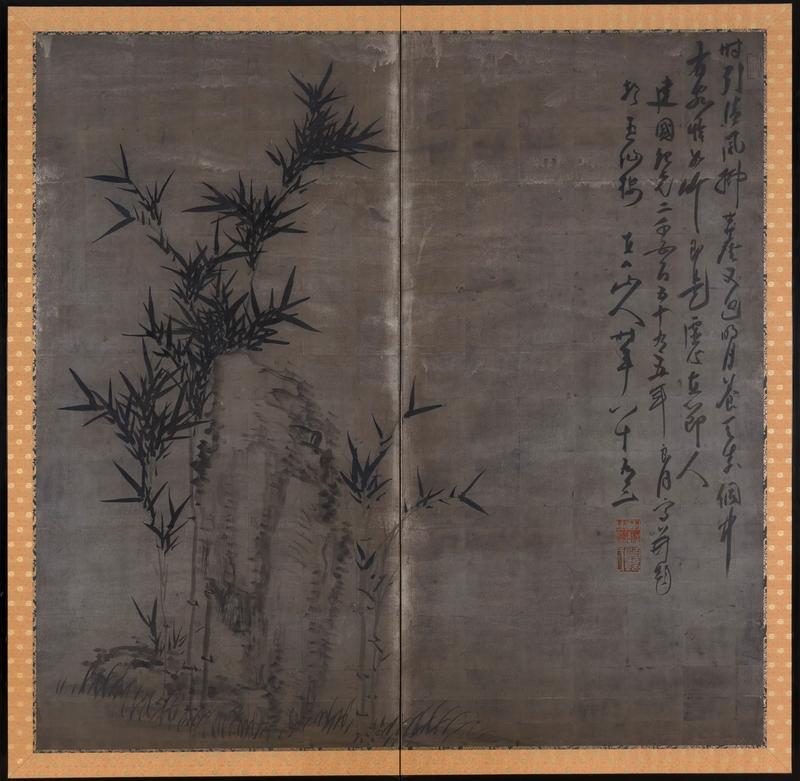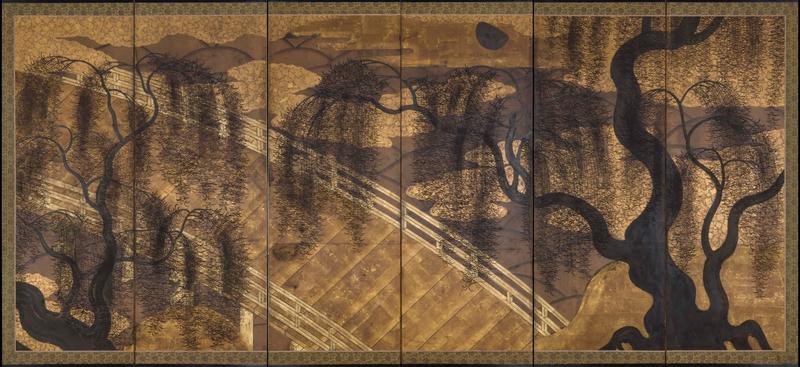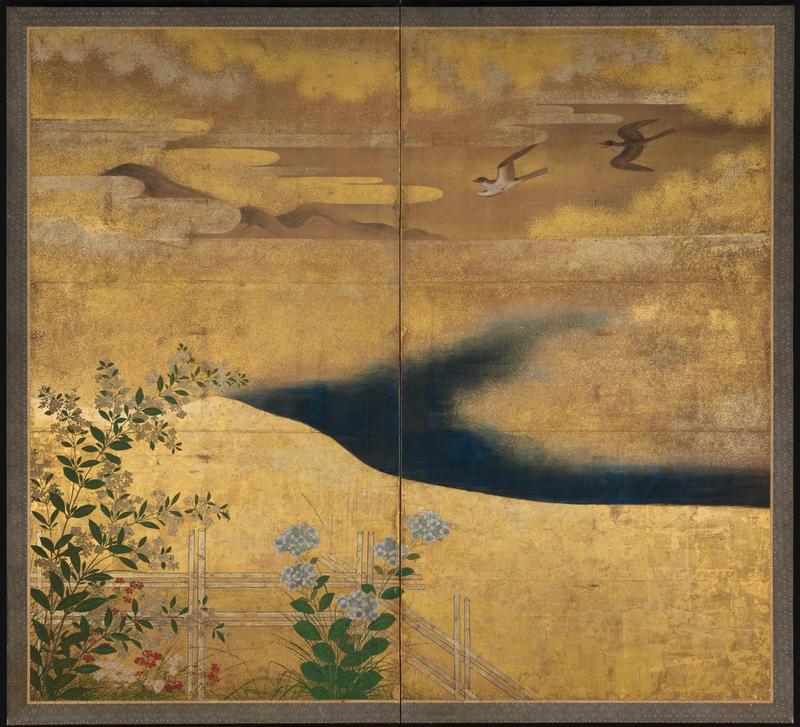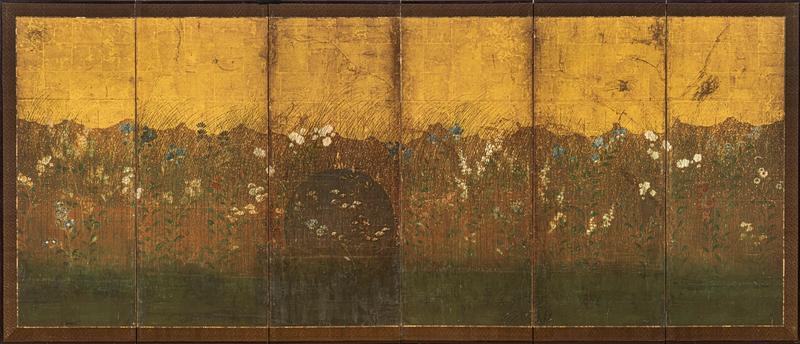A six-fold paper screen painted in ink, colour and gold on a gold and buff ground with yamabuki (kerria roses) rendered in gold and moriage (raised design) beside a stream running across a hilly landscape; the entire screen divided in half by a stylised zigzag design (katamigawari).
Attributed to Rimpa School,Japan, 17th century, Momoyama–Edo period.
The yamabuki (kerria flowers) have two major classical associations in Japan: Ide no Tamagawa (the Ide Jewel River) in the ancient capital Kyoto and a 15th-century anecdote of the warlord Ōta Dōkan.
First, the Ide Jewel River located in the south of Kyoto has been famous for its kerria blossoms—their beauty has been praised in many poems from the early period including those in ‘Collection of Japanese Poems Ancient and Modern’ (Kokinwakashū, compiled in the early 10th century), ‘Collection of Gleanings’ (Shūiwakashū, compiled in the early 11th century), and ‘New Collection of Japanese Poems Ancient and Modern’ (Shinkokinwakashū, compiled in the early 13th century). With a stream running through knolls, this screen may allude to the kerria flowers surrounding this famous river in Kyoto.
Secondly, another significant association with kerria roses is a story of the medieval warlord Ōta Dōkan (1432-1486). Legend has it that Ōta Dōkan went on a falconry expedition and was caught in a sudden downpour of rain. He stopped at a nearby peasant’s cottage to borrow a mino (straw raincoat). Instead of offering a raincoat to Dōkan, a girl from the cottage presented a branch of kerria flowers without saying a word. Disappointed and disgruntled, Dōkan left the cottage. Soon after, his retainer informed him of a 10th-century poem by the Imperial Prince Kaneakira (914-987):
Nanae yae
hana wa sakedomo
yamabuki no
Mi no (Mino) hitotsu dani
nakizo kanashiki
Although kerria roses
have numerous petals
I lament that
they do not have
any fruits (mi no)
Here, ‘Mi no’ (the same sound as ‘mino [raincoat]’) means ‘fruits’ in Japanese, saying that the kerria roses do not bear any mino (fruits). As the girl was too embarrassed to say that she did not have a mino (raincoat) to offer to the warlord, she presented a branch kerria to apologise; she alluded to this classical poem, playing on the words mino that means both ‘fruits’ and ‘raincoat’ to indicate that no mino (raincoat) was available. Ashamed of not having realised the meaning of the kerria branch presented by the girl, Dōkan is said to have reformed himself after this event—he studied classical poetry more than before and ultimately became a renowned poet of the time.
In the early Modern period when this screen was created, this anecdote was well known amongst educated people. Seeing kerria roses would have reminded viewers of this Ōta Dōkan’s story. The line ‘nanae yae’ in the above classical poem means multiple layers (literally, ‘seven layers and eight layers’) and the multiple knolls in this painting may also be alluding to it.
Very few screens depicting kerria roses from this period have survived and only a few examples are known today. A pair of screens with cherry and kerria flowers attributed to Tawaraya Sōtatsu (act. early 17th century) are housed in the Tokyo National Museum. For this pair depicting kerria roses in gold and moriage (raised design), in a similar manner as in the current example:
https://colbase.nich.go.jp/collection_items/tnm/A-301?locale=en
(Edo period, c. 1624-44, accession number: A-301, Tokyo National Museum).
Also particularly noteworthy is the bold and striking design of this screen—a zigzag line divides the whole composition in two. Such composition, so-called katamigawari (differing in halves), was especially popular for kimono and costume designs, and eventually for decorative arts such as ceramics and lacquerware during the Momoyama and early Edo period. One can find many examples of such designs in Noh costumes, tea utensils or Kōdaiji maki-e lacquerware (derived from a temple in Kyoto, Kōdaiji, its interior and furnishings are decorated with similar distinctive designs and with autumn grasses). However, this decorative katamigawari design is rarely seen in the composition of surviving paintings and this screen is an extraordinary example from this perspective. For an example of lacquerware in the Kōdaiji style with a similar zigzag design housed in The Metropolitan Museum of Art, New York, visit:
https://www.metmuseum.org/art/collection/search/44884 (Stationery Box in Kōdaiji style, Momoyama period, early 17th century, accession Number: 1987.82a, b, The Metropolitan Museum of Art).
For a comparative example with a bold, geometric composition from the early 17th century, see a pair of screens depicting various flowers on a gold and silver ground divided with a zigzag line, bearing the Rimpa School’s Inen seals, published in: Shirahata Yoshi et.al., Jidai Byobu [Period Screens], (Kyoto, 1974), no. 19.
In addition to the aforementioned comparative example of kerria flowers in the Tokyo National Museum pair of screens, the sophisticated combination of delicate painting and bold, stylised design suggests that this screen is most likely from the Rimpa School. Rimpa School (also spelled Rinpa School) is one of the major historical schools of Japanese decorative painting and applied arts. It was created in the 17th century in Kyoto by the artists Hon'ami Kōetsu (1558-1637) and Tawaraya Sōtatsu (d. c. 1643). The style was first formulated by Sōtatsu as a revival of the classical courtly tradition and the traditional Japanese Yamato-e painting style in a bold and stylised manner. Rimpa School, although it is more a federation of artists than a hereditary school, eventually absorbed and broadened Japanese classical Tosa themes, identified with a specific style and range of subject matter, and established its uniquely Japanese decorative style, which is still influencing artists today.
Screens

An eight-fold screen depicting flowers of the four seasons

A pair of six-fold screens depicting ‘One Hundred Boys'

A pair of six-fold screens depicting the maritime routes of the Seto Inland Sea and of the north of Kyushu Island

Tanomura Chokunyu - screen painted in ink on a silver ground with a rock, bamboo and calligraphy

A pair of six-fold paper with sweetfish

A pair of six-fold screens with clematis

A six-fold screen with a covey of uzura and chicks

A six-fold screen with grape vines

A two-fold screen with chrysanthemums

A pair of six-fold paper screens with the Plains at Musashino

A pair of four-fold screens with kuri flowers

Four fusuma by Nagasawa Rosetsu

A six-fold screen with autumn flowers and grasses

A paper screen with the Uji river and its bridge

A pair of six-fold screens with scattered fans

A two-fold screen with a river landscape

A two-fold screen with court ladies

A pair of six-fold screens with poem slips from the 17th century

A two-fold screen with the Uji River and its bridge

A six-fold paper screen with the Plains at Musashino

A six-fold paper screen with poem slips






